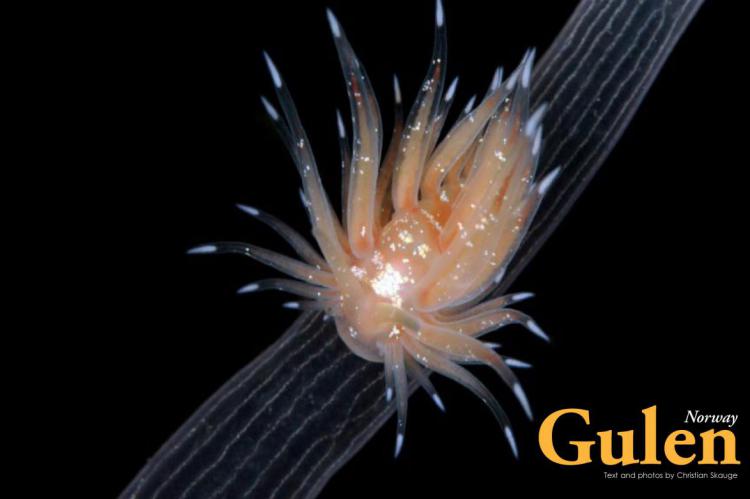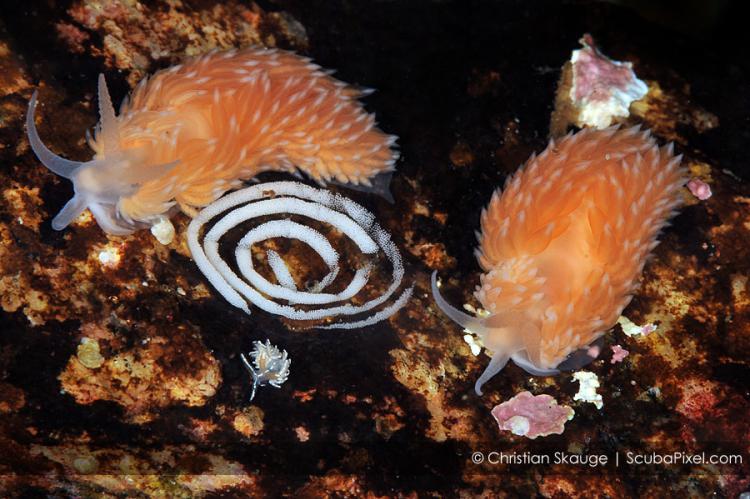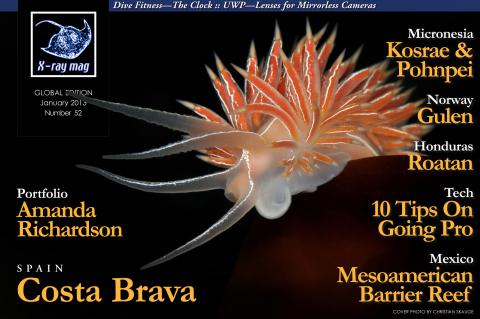Gulen, Norway
Cold water diving will never be the same after a visit to Gulen situated north of Bergen on the Norwegian west coast. Here, history meets present day, the deep ocean meets kelp forest and the gargantuan meets the miniscule.
The area at the mouth of the Sognefjord is as rich in marine splendour as it is beautiful above the surface. The world’s longest fjord, it cuts some 220 kilometres into the Norwegian west coast and an area of great strategic importance during World War II. Consequently, the area is strewn with spectacular wrecks of freighters and warships and in terms of rusty WWII action, few places in the world can compete. A week at Gulen leaves one with the chance of being properly “wrecked”.
Norway’s best wreck
One of Gulen’s signature dives is the 122 meter long German freighter SS Frankenwald. Practically a cliché, the Frankenwald is a virtual window into history, a piece of WWII memorabilia found nowhere else. Laid bare by corrosion, the deck slopes from 24 to 34 meters toward the bow of the ship. Even though bottom time is decent, many dives are required to properly explore the superstructure, cargo holds and the interior. Weighing in at 5,032 tons, the grand old lady wreck is extremely well-preserved, offering so many different dives that people come back year after year.
The stern rests on the sandy bottom 44 meters and almost resembles a submarine conning tower when viewed from behind. After spending as much time as possible on the wreck, divers can ascend to the ship’s spectacular aft mast for a safety stop. Rising from 20 to 7 meters, the structure is entirely encased with anemones and teeming with critters and little fish. Several years ago, the Frankenwald was voted best wreck in Norway by the readers of Norwegian dive magazine Dykking. And rightly so! Hovering motionless above the Frankenwald in good visibility is an out-of-this-world experience not to be missed.
Twin wrecks at Sail Rock
Also not to be missed are the stunning twin wrecks of SS Ferndale and SS Parat. On 16 December 1944, the 116-meter long freighter Ferndale was heading north in the darkness when she ran aground on Sail Rock, 40 minutes north of Gulen Dive Resort. A sitting duck, the Ferndale came under attack from allied aircraft the next morning. In the fierce battle that ensued, the allies lost two Mosquito fighter-bombers, but still managed to sink both Ferndale and the salvage vessel Parat which had been called in for the rescue.
Today, the Ferndale sits upright on a slope ending at a depth of only 8-10 meters. The bow area was salvaged after the war, with only bits and pieces remaining. In stark contrast, the intact midship and stern remain at 34 meters. From this vantage point, one can look down on the Parat, resting a meter or so behind Fernedale. It is almost a miracle that the large freighter did not crush the small salvage vessel when she sank. The Parat is a dive for experienced tech divers, with trimix required between depths of 45 to 60 meters.
After admiring both wrecks, deco and safety stops are done around the spectacular Sail Rock, the sides of which are completely covered with sea plumes, dead men’s finger coral, dahlia anemones and sea squirts. The quantity of fish and invertebrates found here is simply astonishing. It is wise to make room for an extra long deco stop if you don’t want to miss out on the rock. Some underwater photographers have been known to ignore the wrecks entirely and concentrate on Sail Rock’s colourful plethora of marine wildlife. Even with the unique twin wrecks close by, it is a world-class dive in its own right.
Rust for everyone
Gulen Dive Resort takes divers to no less than 15 different wrecks, ranging from the beginner-friendly Solvang at 15 meters to the technical deep-dive of SS Lynx at 90-100 meters. In between, most divers will find a wreck at suitable depth, be it the Havda, Bandak, Server, Welheim, Oldenburg, Inger Seks or the newly discovered minelayer KNM Uller at 55 meters. The latter is the only wreck known to have been sunk by Norwegian seaplanes during WWII. Scattered on the bottom beside the beautiful 27 meter long vessel are ominous-looking mines and a cannon elevated towards the surface as if she’s still trying to fend off her aggressors.
On the boat ride out, divers are briefed not only on the dive itself, but you will also the often exciting and violent history of the wrecks. At Gulen, history is never more than a few meters below the surface. (...)
Download the full article ⬇︎

Originally published
X-Ray Mag #52
Diving Spain's Costa Brava; Honduras' Roatan; Micronesia's Kosrae & Pohnpei; Diving Gulen, Norwegian fjord; Kids Scuba Malaysia Mabul-Sipadan Camp; Jim Hellemn profile; Why scientific diving safer; Diving the Mesoamerican Barrier Reef; Dive fitness: The Clock; Tech: 10 tips on going pro; When sharks really attack; All about mirrorless cameras lenses; Amanda Richardson portfolio; Plus news and discoveries, equipment and training news, books and media, underwater photo and video equipment, turtle news, shark tales, whale tales and much more...



